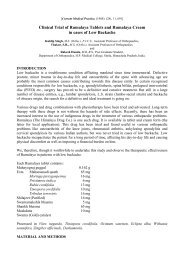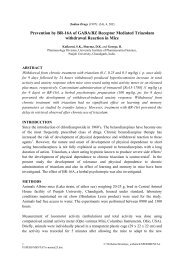Ejaculatio praecox (Treatment with an indigenous drug) - Himalaya
Ejaculatio praecox (Treatment with an indigenous drug) - Himalaya
Ejaculatio praecox (Treatment with an indigenous drug) - Himalaya
Create successful ePaper yourself
Turn your PDF publications into a flip-book with our unique Google optimized e-Paper software.
(The Indi<strong>an</strong> Practitioner (1968): November, 853)<br />
<strong>Ejaculatio</strong> Praecox<br />
(<strong>Treatment</strong> <strong>with</strong> <strong>an</strong> Indigenous Drug)<br />
Bedi, B.M.S., M.D.,<br />
Reader in Dermatology & Venereology, <strong>an</strong>d Head of the Department of Venereology,<br />
Maul<strong>an</strong>a Azad Medical College <strong>an</strong>d Associated Irwin & G.B. P<strong>an</strong>t Hospitals, New Delhi, India,<br />
At present Reader in Dermatology <strong>an</strong>d Venereology, H.P. Medical College, Simla, H.P., India.<br />
INTRODUCTION<br />
Sex has a great influence on the working of the mind as well as the body. No wonder the problems<br />
pertaining to sex may result in great damage to the normal functioning of the individual as a whole.<br />
<strong>Ejaculatio</strong>n <strong>praecox</strong> or premature ejaculation is one such malady which not only produces great<br />
dissatisfaction in sexual relationship but may also result in great frustration to both the partners.<br />
Having cut a sorry figure, the male feels a great sense of shame <strong>an</strong>d the female who was sexually<br />
aroused <strong>an</strong>d failed to get satisfying sexual gratification (orgasm), usually develops a sense of<br />
revulsion, repulsion <strong>an</strong>d hatred, as a consequence. The male having failed in his perform<strong>an</strong>ce<br />
suffers unbearable mental agony <strong>an</strong>d a peculiar sex inferiority complex. He feels unable to face his<br />
wife. This directly tells upon marital happiness. There are possibilities that the male may become a<br />
complete psychic wreck after repetitions of such disappointing perform<strong>an</strong>ces, <strong>an</strong>d the frustrated<br />
female becomes extremely irritable <strong>an</strong>d difficult to live <strong>with</strong>.<br />
There are a number of possible causes for premature ejaculation, but the single most import<strong>an</strong>t<br />
cause is the congestion in the region of the prostate. M<strong>an</strong>y environmental causes contribute to this.<br />
In modern society a m<strong>an</strong> is sexually aroused by seeing stimulating sexy pictures <strong>an</strong>d hoardings, by<br />
reading provocative literature <strong>an</strong>d seeing around him seductively <strong>an</strong>d sometimes sc<strong>an</strong>tily clad<br />
females. To this may be added the factor of hot spicy diet, alcoholic beverages, aphrodisiac <strong>drug</strong>s, a<br />
loaded rectum <strong>an</strong>d/or other pathological conditions of the rectum <strong>an</strong>d prostate. Because of the<br />
congestion in this region of the prostate there is profuse secretions from the gl<strong>an</strong>ds <strong>with</strong> the result<br />
that the seminal vesicles are fully engorged <strong>with</strong> secretions. In this condition <strong>an</strong>y slight stimulation<br />
in the form of fondling, sex-play, amorous embracing, touching the genitalia or attempt at<br />
penetration further aggravates the engorgement which triggers off a forceful contraction of the<br />
seminal vesicles resulting in premature ejaculation of semen.<br />
Such patients usually have recourse to quacks for treatment because they put up cheap<br />
advertisements guar<strong>an</strong>teeing sexual potency. Since the above mech<strong>an</strong>ism is not known to them<br />
these quacks prescribe aphrodisiacs which add to congestion <strong>an</strong>d worsen the condition <strong>an</strong>d the<br />
patient goes from bad to worse.<br />
While it is easy to give general instructions like recommending a bl<strong>an</strong>d non-spicy diet, avoiding<br />
alcoholic beverages, treating of constipation, cold sitz-baths, etc., it is necessary to adopt a rational<br />
scientific approach to reduce the congestion in this region.<br />
Out attention was drawn to the report by Jussawalla (1956) regarding the decongestive effect<br />
produced on the prostrate by <strong>an</strong> <strong>indigenous</strong> <strong>drug</strong> called ‘Spem<strong>an</strong>’ (<strong>Himalaya</strong> Drug Co.). Gour &<br />
Gupta (1959) used it in the treatment of male sexual disorders <strong>an</strong>d reported improvement in 16 out<br />
of 18 patients of premature ejaculation. R<strong>an</strong>ade & Raje (1958) reported marked improvement in
cases of spermatorrhoea <strong>an</strong>d nocturnal emissions. P<strong>an</strong>tulu (1966) demonstrated the usefulness of<br />
‘Spem<strong>an</strong>’ in treating 10 cases of premature ejaculation. Heilig (1968) suggests that ‘Spem<strong>an</strong>’ seems<br />
to act as a brake on the spinal regulators of ejaculation <strong>an</strong>d thereby it slows down seminal<br />
discharge.<br />
With these useful reports <strong>an</strong>d scientific background, it was decided to have a trial of ‘Spem<strong>an</strong>’ in<br />
the treatment of ejaculatio <strong>praecox</strong>.<br />
Composition: ‘Spem<strong>an</strong>’ is a herbal preparation m<strong>an</strong>ufactured by The <strong>Himalaya</strong> Drug Co., <strong>an</strong>d has<br />
the following composition:<br />
Orchis mascula (Salap misri)<br />
per tablet<br />
64.8 mg.<br />
Lactuca scariola (Kahu) 16.2 mg.<br />
Hygrophila spinosa (Talmakh<strong>an</strong>a) 32.4 mg.<br />
Mucuna pruriens (Kavach) 16.2 mg.<br />
Exts. Parmelia parlata (Chharila) 16.2 mg.<br />
Argyreia speciosa (Vridhadharaka) 32.4 mg.<br />
Tribulus terrestris (Gokhru) 32.4 mg.<br />
Leptadenia reticulata (Jiv<strong>an</strong>ti) 32.4 mg.<br />
Suvarnav<strong>an</strong>g (Mosaic gold) 16.2 mg.<br />
The mode of action of various ingredients is as under:<br />
Orchis mascula : Highly nutritious, acts as tonic in loss of sexual power.<br />
Lactuca scariola : Anodyne, sedative <strong>an</strong>d demulcent.<br />
Hydrophila spinosa : Acts as tonic.<br />
Mucuna pruriens : Astringent <strong>an</strong>d nerve tonic.<br />
Parmelia parlata : Acts as tonic <strong>an</strong>d is efficacious in spermatorrhoea.<br />
Tribulus terrestris : Diuretic, sexual tonic.<br />
Leptadenia reticulata : A good restorative <strong>an</strong>d tonic; promotes spermatogenesis.<br />
Suvarnav<strong>an</strong>g : An invigorator <strong>an</strong>d rejuvenator.<br />
Pharmacology: The action of ‘Spem<strong>an</strong>’ was experimentally studied on the seminal vesicles of<br />
guinea-pigs (R<strong>an</strong>ade, 1956). ‘Spem<strong>an</strong>’ considerably enh<strong>an</strong>ced the contractions produced by a fixed<br />
dose of adrenaline, thereby proving that ‘Spem<strong>an</strong>’ produces more complete <strong>an</strong>d powerful<br />
contractions of the seminal vesicles.<br />
MATERIAL AND METHODS<br />
A series of 62 patients suffering from ejaculatio <strong>praecox</strong> were taken up for study. Out of these 7<br />
patients could not be followed-up since they were not regular <strong>with</strong> treatment.<br />
The age group of various patients was as under:<br />
Age group No. of patients<br />
25–30 20<br />
30-35 20<br />
35-40 10<br />
40-45 5<br />
This table shows that the majority of patients belonged to the age groups of 25-40 — the sexually<br />
active period.
All these patients were thoroughly interrogated regarding their trouble, their personal history <strong>an</strong>d<br />
past sexual perform<strong>an</strong>ce. The onset of the trouble in most cases dated back to 2 months to 16<br />
months. Patients <strong>with</strong> <strong>an</strong> occasional complaint or a solitary episode were not included in this study.<br />
Each <strong>an</strong>d every patient was thoroughly examine for the presence of secondary sex characters <strong>an</strong>d<br />
for the absence of <strong>an</strong>y org<strong>an</strong>ic abnormality. Per rectum examination to exclude piles, fissures <strong>an</strong>d<br />
enlarged prostate was done in every case.<br />
The following general instructions were given to the patients:<br />
1. To take a bl<strong>an</strong>d diet preferably bulky vegetables <strong>with</strong> lot of roughage.<br />
2. To avoid alcoholic beverages.<br />
3. To avoid constipation <strong>an</strong>d if present, the same was treated by laxatives.<br />
4. To avoid stimulating sexy literature.<br />
5. Sexual abstinence for a period of 4–6 weeks.<br />
Dosage schedule: Each patient was put on ‘Spem<strong>an</strong>’ 2 tablets three times a day.<br />
Period of study: The study on each patient lasted for a period of 4-6 months.<br />
RESULTS<br />
Out of the 55 patients thus studied, the results were assessed as under:<br />
Good : Increase in retention power <strong>an</strong>d a completely satisfactory perform<strong>an</strong>ce of the sexual act.<br />
Fair : Increase in retention power but sexual act, though much improved, not fully satisfactory.<br />
Poor : No or little ch<strong>an</strong>ge.<br />
The results are tabulated below:<br />
Out of a total of 55 patients<br />
Response No. of patients Percentage<br />
Good<br />
(complete relief from symptom)<br />
33 60<br />
Fair 7 12.7<br />
Poor 15 27.3<br />
About 50% of the patients improved <strong>with</strong>in two months, the rest took 4-6 months.<br />
This study shows that a majority of the patients, 60% were completely cured while 12.7% showed<br />
fair improvement.<br />
In the patients (27.3%) who showed poor response there were some other psychological factors like<br />
job-insecurity, poverty, worry, which were hindering the progress.<br />
It is suggested that a trial of ‘Spem<strong>an</strong> Forte’ which, in addition, contains Rauwolfia serpentina<br />
(‘Serpina’) may prove more useful in this group which also has psychological problems.<br />
Side effects: No untoward side effects were observed during the period of this trial which lasted for<br />
4-6 months.<br />
DISCUSSION<br />
From the above study it is obvious that ‘Spem<strong>an</strong>’ has been found to be very efficacious <strong>an</strong>d useful<br />
in the treatment of ejaculatio <strong>praecox</strong>, a most distressing sexual malady that leaves the sufferer<br />
prostrate <strong>with</strong> misery.
Sixty per cent of the patients were completely cured while 12.7% showed fair response.<br />
‘Spem<strong>an</strong>’ by its action on the seminal vesicles causes forceful contraction of seminal vesicles <strong>an</strong>d<br />
results in complete evacuation thereby acting as a potent decongest<strong>an</strong>t. The thorough emptying of<br />
the seminal vesicles helps to increase retentive power thereby contributing to a harmonious,<br />
satisfying sexual act.<br />
Moreover, since the burning micturition syndrome is also being attributed to congestion in the<br />
prostate <strong>an</strong>d bladder, it is being contemplated to try ‘Spem<strong>an</strong>’ in the treatment of the burning<br />
micturition syndrome.<br />
SUMMARY<br />
A study on 55 patients of ejaculatio <strong>praecox</strong> <strong>with</strong> ‘Spem<strong>an</strong>’ for a period of 4-6 months showed<br />
complete cure in 60% of patients <strong>an</strong>d fair response in 12.7%. This <strong>drug</strong> has been thus found to be<br />
very useful in the treatment of premature ejaculation.<br />
REFERENCES<br />
1. Gour, K.N. <strong>an</strong>d Gupta, Sudhir (1959): Curr. Med. Pract., 3: 135.<br />
2. Heilig, Robert (1968): Probe, 7: 49.<br />
3. Jussawalla, D.J. (1956): Jour. Ind. Med. Prof., 10: 964.<br />
4. P<strong>an</strong>tulu, P.K. (1962): Probe, 2: 60.<br />
5. R<strong>an</strong>ade, S.N. <strong>an</strong>d Raje, G.K. (1958): The Antiseptic, 2: 111.<br />
6. R<strong>an</strong>ade, S.N. (1956): Ind. J. of Pharm., 7: 310.




